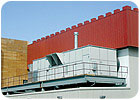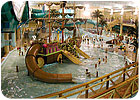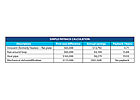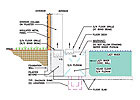
Each of the two heat recovery units is mounted on a platform. The flat plate heat exchangers recover up to 65% of the energy.
Alaska is known for the majestic outdoor beauty of Mount McKinley, its vast lands of forest, and abundant wildlife. Indoors, Alaska is also home to one of the largest enclosed water parks in the United States. H2Oasis, on a three-acre site in Anchorage, has proven to be a paradise in the midst of the arctic tundra for people to escape into a tropical destination without spending a bundle. This tropical indoor water park has the capacity to hold over 1,000 occupants in the 55-ft high building, encompassing 40,000 sq ft in south Anchorage.
This project started with an idea that grew into what is now literally the "hottest" spot in Alaska. The water park boasts a lazy river, pirate ship, wave pool, water cannons, water coaster, body slides, and pools for different groups. The park received a permit to start construction in July 2001 and officially opened to the public on March 2003. The cost to build this recreational facility in the northernmost state was $7.5 million. Over 140,000 guests a year come to enjoy the simulated tropical oasis in the sub-arctic Anchorage climatic region, an incredible attraction for a city with just 300,000 residents.
Running H2Oasis is no easy task, and keeping it moving everyday takes considerable resources. The electric utility bill for this oasis in the snow ranges between $16,000 to $18,000 a month. The monthly gas utility cost varies between $6,000 and $12,000. The water bill to run H2Oasis is $1,500 to $2,000 a month.
There were many architectural firsts that make this building unique in North America. H2Oasis was the first water park in North America to have an enclosed Master Blaster, a 505-ft long twisting water coaster. There are presently 50 Master Blasters in North America, and only three of these are part of an indoor water park. The modern marvel also makes a 450-degree turn around the south tower. This Master Blaster stands four stories high in one corner of the water park. The main pumps supply the 5,500 gpm of water required to propel humans down the undulating chute.
Designing the ventilation system for the water park created some unique challenges. Customer comfort was paramount, and that required maintaining the right mix of temperature and humidity. Here in Alaska, the summer temperatures rarely get over 70°F. However, customer comfort dictates that the water park environment be kept at a balmy 86°, and 60% rh year round. This means that even in summer, the cool, dry outside air has to be heated. In winter, the conditions require even more heating, as the outside air can be as low as -25°, containing virtually no moisture.
With the required year-round heating of the outside air, proper equipment selection was necessary to meet targeted indoor conditions and minimize energy consumption. The major variable in choosing equipment was the high quantities of moisture generated indoors. Preliminary calculations indicated that up to 944 lbs of water an hour could be generated, a large load for any ventilation system. Between the heated pool, the even hotter spas, water spraying from various rides, and damp towels and bodies everywhere, humidity control was a serious problem to overcome.

TABLE 1. Heat recovery worksheet.
TECHNICAL ISSUES
Initially, the developers sought to mimic other water parks, swimming pools, and natatoriums around the country. Their assumption was that a dehumidification system, with mechanical refrigeration and reheat, would be needed because it was the most commonly used equipment from North Dakota to Florida. However, Anchorage has a fairly cool, dry summer and the calculations led to a different result. Our analysis was based on the following factors:- ASHRAE states that recreational pools need to be maintained at 84° water temperature.
- ASHRAE also states that the room air temperature has to be at least 2° warmer than the water, to keep condensation in check. (Air, if cooler than pool water, will cause condensation and "misting").
- The ambient summer 1% design conditions are 73° db and 60° wb, according to ASHRAE weather data tables.
With these variables, a spreadsheet was created, (Table 1), to determine the outside air needed to dehumidify the air and restrict the indoor humidity from exceeding 60% rh. Two conclusions were derived: (1) The outside air always has to be heated, winter and summer, because the 86° indoor setpoint is well above ambient; and (2) The heating causes the air to "dry" and thus no mechanical refrigeration was needed to dehumidify the space. The more outside air is brought in, the more it reduces the humidity indoors, as long as the Anchorage temperature regime is applied.
Thus, the control sequence was set to reduce outside air based on energy considerations, but sufficient to keep the humidity from exceeding its mark.
Beyond the standard design elements for any large assembly area, the quantity of water in the environment presented another consideration. The pertinent calculations used to determine the effect on the indoor environment were performed as follows.
CONDENSATION
The first concern to address was condensation and verifying that the thermal envelope R-values were adequate. This was done by calculating the rate of heat transfer through the walls, and verifying that the temperature at the wall surface would stay above the dewpoint.Condensation On Walls
Total R-value, wall = 0.17 (exterior air film) + 19 (wall panel, pre-insulated) + 0.68 (interior air film) = 19.85.
Q = 1/R x DT = 86 - (-25)/19.85 = 5.59 Btuh/sq ft
DT1 = 5.59 x 0.68 = 3.80°
DTinside = 86 - 3.80 = 82.20°
where Q = heat loss, Btuh/sq ft, DT = temperature difference,

Evaporation from the wave pool and spa areas of the water park, combined with people gain, created the demand for incoming air to absorb 944 lbs/hr of water to maintain proper conditions.
EVAPORATION
Once it was determined that condensation was not a concern, the next step was to figure out exactly how much moisture would be generated internally and need to be removed. To calculate the amount of water that would evaporate due to the various pools and people, the following equation was used:(Equation 3) wp = 0.1A x (pw - pa) x Fa
Where:
wp = Evaporated moisture (lb/hr)
A = Area, (sq ft)
pw = Saturation pressure, evaporated water vapor, (in. of mercury)
pa = Partial pressure, water vapor, in ambient air, (in. of mercury)
Fa = Activity factor, (from ASHRAE 1999 Table)
In the case of the Alaska water park, the following data was used: Saturated vapor pressure, spa: ps = 2.11661 in. Hg. at 103°; saturated vapor pressure, wave pool: ps = 2.17608 in. Hg. at 84°; saturated vapor pressure, air: pa = 1.25388 08 in. Hg. at 86°; room air dewpoint = 74.5°, Þ ps =0.855
Then for each of the components, the contributed moisture was calculated as follows:
Vapor produced by the spa:
wp = 0.1 x 354 x (2.11661-0.855) x 1.0 = 44.66 lb/hr
Vapor produced by the wave pools:
wp = 0.1 x 15,335 sq ft x (1.17608 - 0.855) x 1.5 = 738.6 lb/hr
People Gain
wp = 0.325 lb/hr x person x 200 occupants = 65 lb/hr
Total vapor produced = 44.66 + 738.6 + 65 = 944 lbs/hr
This means that the incoming air must be capable of absorbing 944 lbs/hr water, without exceeding the 86°, 60% rh indoor conditions recommended by ASHRAE1.

TABLE 2. Heat recovery payback.
DEHUMIDIFICATION
Having defined the amount of moisture that needed to be removed from the atmosphere, the next step was to define the method of calculating just how much air would be required to accomplish this.From the psychrometric chart:
- Indoor moisture content at 86°, 60% rh = 0.016 lb/lb of air
- Outdoor moisture content at 71°, 60° wb = 0.086 lb/lb of air
The available humidity pick-up between outside ambient conditions in the summer and indoor ambient conditions is the difference between these two values = 0.0074 lb/lb of air.
Density of air at standard temperature and pressure = 13.5 cu ft/lb
D moisture = 0.0074-13.5 = 0.000548 lb/cu ft of air
In order to calculate the quantity of air necessary to absorb 944 lb/hr of moisture, the following calculation was performed:
(Equation 4) cfm = 944 lbs/hr/0.000548 lb/cu ft/ 60 min/hr = 28,710 cfm
As this calculation was performed using data from the peak design condition for summer, (when incoming air would be at peak humidity, and therefore have the least absorption capability), the 28,710 cfm represents the maximum outside air needed for dehumidification. It should be noted that in the winter, a mere 14,000 cfm of outside air is adequate for fully dehumidifying the space; there is very little water vapor in the air at temperatures below freezing.

FIGURE 1. Supply air plenum detail.
HEAT RECOVERY
The spreadsheet in Table 1 uses the above calculations to determine the amount of ventilation year round, and the amount of heating that will be required for each calendar month. After the cool incoming air is heated by the outgoing, moist air in the heat recovery plate exchangers, it still would not be warm enough for the comfort of the occupants; supplemental heat has to be added. The Swimming Pool Code for Alaska dictates a minimum of 6 ach for ventilation in the pool area, a simple calculation yielding 114,000 cfm for the volume of the building.To accomplish this, two 57,000-cfm Innovent (formerly Heatex) heat recovery units were specified, each capable of adding 1,650 MBh. The month-by-month calculation allowed the designer to pick the maximum heat input value, because the peak load occurs in December, and not January, which is Anchorage's coldest month. It also includes estimates for the cost of heating. It should be noted that at the time this spreadsheet was developed, natural gas was selling for $0.45/Therm, so that as the cost of natural gas has gone up, the simple payback has speeded up.
Due to the ever-rising costs of fuel, extensive studies were performed to make sure the most efficient equipment was specified. After careful consideration, an air-to-air flat plate heat recovery ventilation unit (HRV) was selected, as it would do the best job of maximizing efficiency and keeping humidity at the desired levels. Table 2 shows the analysis for selecting flat plate heat exchangers.
As Table 2 indicates, the flat plate option was overwhelmingly the right choice for this project. With the significant increases lately in fuel prices, the payback has been accelerated. Obviously, with varying climate conditions and utility costs, the results of the analysis will differ in other regions.
Another special concern was avoiding stratification of heat and humidity inside the 50-ft tall structure. To keep the hot air flowing throughout, the engineering solution was to supply most of the air via a below-floor plenum (Figure 1). As this was already excavated volume, with one wall being the foundation itself and the other the vertical side of the lazy river, using it as a plenum was a creative idea, which did not add any construction costs. This use of an underground concrete supply air plenum gave the water park a clean, uncluttered look, delivering hot air that migrates up to the return air grilles mounted high at the roof peak.
In essence, the airflow creates a very efficient delivery pattern, one that minimizes stratification and reduces pockets of humidity in the space. Any water that splashes from the floor grilles is collected in sumps and pumped out to avoid standing puddles, which could create a health hazard.
One constant feature to be found at any great water park is the "lazy river." H2Oasis has its own lazy river called the Never Ending River. The water stream flows at 5 miles per hour, in a channel 575-ft long, along the perimeter of the 40,500-sq-ft building. H2Oasis uses the Never Ending River to promote fitness and fun together, by offering a program called Riverwalk. The program allows guests to exercise against the current of the Never Ending River. More than 200,000 gal of water are filtered for the Never Ending River everyday.
Elsewhere, the water park's wave pool reaches a depth of 6 ft, sloping to 1 ft at the shallow end. This feature can generate up to 4-ft waves. The shallow part of the pool has a "mushroom" water drop; the mushroom rains down water from its brim.
Another special feature of H2Oasis is the children's lagoon. What makes this lagoon unique is the Sea Dragon Pirate Ship. This pirate ship consists of six water cannons, four on the ship and two on the "beach." The pirate ship extends 40-ft in length, inside a 12-in. deep pool. There are seven slides on the pirate ship for children to play on. About 400 gpm of water race through the ship.
After years of planning and construction, Alaska has its very own water park. Many people were skeptical of the idea that a water park could be sustained, let alone the technical challenges of building one. Numerous people inside and outside the state of Alaska pulled together to build one of the most unique water parks in the world, making H2Oasis the fifth largest indoor water park in the United States.
